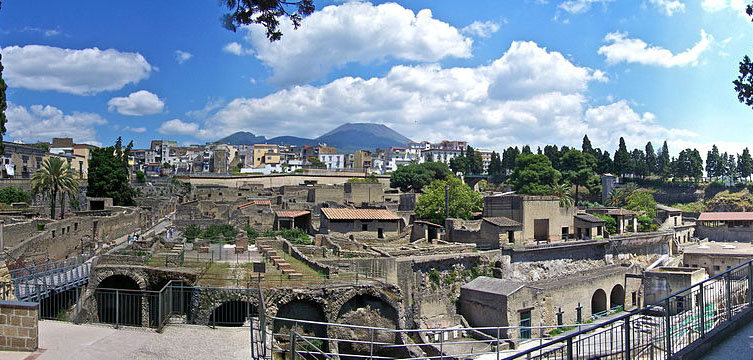While millions of visitors flock to the immense archeological site of Pompeii, Herculaneum, which was also buried by the same eruption of Vesuvius, offers an opportunity to visit the excavations, but on a smaller scale. In fact, on any given day you may find less than 1,000 tourists at the UNESCO World Heritage Site.
The two archaeological sites are complementary and both are rewarding to visit, but in different ways. Pompeii covers a vast space and should not be missed on a trip to the Naples area. In a poll of visitors to both sites, those who first went to Pompeii first and then experienced Herculaneum, expressed that it was the ideal sequence for visits to the archeological treasures. Herculaneum covers a grid of streets, making it easy to navigate. With far fewer visitors and a compact area, it presents a more leisurely way to explore this different side of Roman life than its more cosmopolitan neighbor.
One of the best-preserved Roman houses at Herculaneum, the Bicentenary, has just reopened after being closed to the public for 36 years. Its exquisite paintings have been brought back to life thanks to a revolutionary new technique in artwork conservation.
The three-story House of the Bicentenary is perhaps the most beautiful house of nobility thus far excavated from under the volcanic lava flow that entombed the town. Herculaneum was a wealthier town than Pompeii, with more exquisite architecture, much of which is still to be uncovered. When Vesuvius erupted, it was buried Herculaneum under lava and ash that ranged from 20 to 50 feet in depth. That is significantly more than the 12 feet of ash that buried Pompeii. For years, this has made Herculaneum far more difficult for archaeologists to excavate, which has been going on for almost 300 years. Official excavations began at the site in 1738, under the Bourbon monarchy.
The Bicentenary House features stunning frescoes and mosaics. It was discovered in 1938, two hundred years after excavations of the city began. In the early 1980s, artwork in the 6,400-square-feet building was showing significant signs of instability. It was then closed to the public as conservationists began their work. Black and white photos of the paintings from 1938 show remarkably well-preserved images, but they had almost disappeared before the latest restoration work began.
The house became a laboratory for finding new and innovative treatment methods, as well as materials that could be used, not only in Herculaneum, but in Pompeii as well. Decades ago, the frescoes had been covered in wax in the mistaken belief that it would preserve the artwork. This proved to be a disastrous decision that made the restoration by traditional methods all but impossible. As the wax deteriorated, it caused the paint to powder and flake. Since the method was used widely throughout the region, it actually threatened the survival of many of the artworks that it was meant to protect.
After experimenting with different methods over the course of decades, a rigid gel compound was developed that removed the layer of wax, while leaving the paint below stable enough to be worked on by conservationists. Experts working on the Bicentenary House hope this new technique can be used to save the many other works of ancient art.
If you are planning a trip to the Naples area in the upcoming year, you will want to leave time to visit Herculaneum and the artwork treasures of the Bicentenary House.





